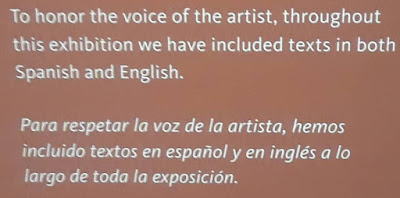While contemplating a good way to wrap up my course on the geography of Latin America, I was fortunate enough to hear this bit of radio journalism.
I thought I recognized the photographer's name and I was even more certain that I recognized her focus on indigenous people as her favored subjects at a certain point in her career.
Indeed, this was the photographer I was thinking of, and I had posted an article about the work of Graciela Iturbide in this space early in 2019. I wrote Mexico Contrasts, In Black & White based on a NYT article before I even went to her exhibit at the Museum of Fine Arts in Boston. (Search the MFA site for her name to see a lot of related stories.)
It was also in early 2019 that I learned of a Frida Kahlo exhibit that was coming to MFA in the same season and some new scholarship around her life and work. I wrote about this at the time in Frida La Pared.
I did not write much about the exhibit itself, but at the time I did post this sign that I had found just outside the gallery.
I have seen a lot of bilingual signage in museums, but I do not think I have ever seen a bilingual sign about bilingual signs. Attention was being called to their use because they were the first such signs used in MFA since it opened in 1876. A Juneteenth 2019 story on WGBH reminds me that this was during a time of controversy and introspection about race and access in the museum.
 |
| Iturbide's Casa de la Muerte (1975) captures Mexican motifs of the dead. |
Lagniappe
Those reading this post now (April 26, 2022) might have an opportunity to visit the Immersive Frida exhibit in Boston or in another city.



